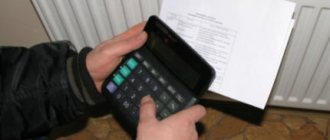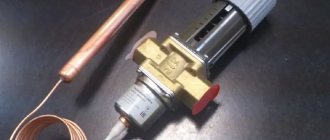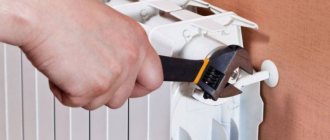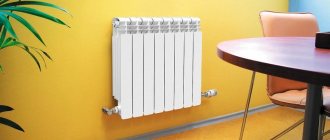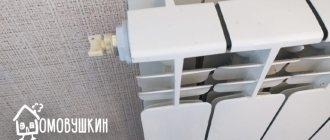Installing a heating meter in your apartment is the best solution for saving your family budget. The installation of the device is carried out in accordance with a certain technology, so the work must be carried out by specialized organizations.
To obtain benefits, it is necessary to focus on the adopted regulations, on the basis of which the flow meter is recognized as being put into operation, and the readings of the device are accepted for calculating the monthly payment.
Why do you need a heating meter?
Probably everyone has encountered problems with central heating batteries. Modern houses are designed with autonomous heating, so that the consumption is calculated for each apartment separately. People who live in older houses do not have such a prerogative. Sometimes they have to suffer because utility services want to save money and turn up the heating, as a result, the temperature in the house drops, and the bills come in sky high, the question arises: what are we paying for then?
Let's consider the main problems of centralized heating:
- The used cubic meters of heat are distributed to all apartments, taking into account data on the area of the apartment from those. passports, but redesigned, enlarged apartments are not taken into account. So you may end up paying more for luckier neighbors.
- Significantly less heat enters the batteries than comes out of the boiler room. In fact, the cost of heating includes heat that does not even enter your apartment.
- The plumbers turn up the heating, you freeze or use additional heating methods (for which you also pay), and the bills come the same.
Important! Considering the listed disadvantages of central heating, one can understand why so many people want to install individual meters. About 30% of the heat we pay for does not reach the apartment.
By installing the device in an apartment, we can check how much heat is supplied and pay only for it. If you don't have enough heating power, you will at least pay an adequate price.
Who should pay how much for heating?
It turns out that in houses that were put into operation in 2012 and later, heat meters should be installed in each apartment by default - developers are required to install them.
Moreover, if the design documentation for an apartment building was developed before 2012 and did not include the installation of an IPU for thermal energy, and the house was built and put into operation later, then the developer has no obligation to install an IPU, this is court practice.
When overhauling in-house engineering heat supply systems since 2012, if technically possible, houses must also be equipped with heat energy meters. However, the capital repair program does not provide for this type of work (LC RF, Article 166).
Owners of apartments in houses equipped with metering devices must pay according to their individual readings, even if one of the neighbors dismantled the meters in their apartment. Thermal energy consumed, provided for general house needs, must also be paid for by all owners of apartment buildings, regardless of the presence or absence of IPU.
Residents who have removed their meters without permission must pay for heating according to established standards. This decision was made by the Constitutional Court of the Russian Federation.
In those houses that were put into operation before 2012, where major repairs have not yet been carried out or have been carried out, but there is no technical possibility of installing building-wide heat meters, heating fees will be charged according to the standards.
If it is technically possible to install distributors, then in order to calculate heating costs based on the readings of the distributors, you need to equip at least 50% of the apartments in the house with them (in this case, at least one apartment must have a heat control unit installed).
The obligation to pay for heating services, which is used for general house needs, always remains.
If there is a building-wide heat energy meter, but there is not a single distributor and not a single heat control unit, the total readings will be divided among all apartments.
Formulas for calculating heating fees can be found in Appendix No. 2 to the “Rules for the provision of utility services to owners and users of premises in apartment buildings and residential buildings,” approved by Decree of the Government of the Russian Federation dated May 6, 2011 No. 354.
Is it possible to install a heat meter in an apartment?
The question: is it allowed to install heat meters in an apartment still remains relevant.
The World Wide Web gives diametrically opposed answers. Perhaps the utility services themselves are misleading people, since they do not really benefit from such modernization. However, we cannot be fooled so easily; after reviewing the legislation, we made an unambiguous conclusion: it is possible to establish, but there are several nuances.
Please note that installing a heat meter in an apartment yourself is not only prohibited, but also very dangerous. Outside interference in the heating system can result in an accident, and if everything goes smoothly, then, in any case, it will not be accepted by the heating service.
If you decide to install such a meter, then you need to do everything according to the rules.
When installation is not possible
There is no legislation prohibiting the installation of your own meter, but there are cases when technically installing it simply does not make sense. This situation is possible in very old houses, where changing the heating system is impossible or not profitable.
Basically, the problem lies in the wiring of the heating system. It comes in two types:
- Vertical system. Heat passes through all floors up and then back. In this case, there are usually several risers per apartment, and a meter will have to be installed on each of them, which is very expensive. Most often, such heating is installed in Khrushchev-era buildings.
- Horizontal - has two pipes, heat enters through one, and through the other it goes out with one riser to the apartment. Therefore, installing a meter will not be a problem.
To be absolutely sure whether a heat meter can be installed in an apartment, contact a specialist. They will conduct an inspection and tell you how effective the modernization will be and how much it will cost to maintain this system.
Heat meters in the legislation of the Russian Federation
It is important to note that in the Russian Federation there is a law that obliges the installation of heat meters in an apartment building at the expense of the residents. If this is not done, then you will have to pay a tariff with a coefficient of 1.5, if not more.
In this case, it does not matter whether you have an individual meter for your apartment; its readings will not be taken into account. Therefore, first make sure that your house has a common meter, and then install an individual one according to the procedure established by law.
Installation of heat meters
The upward trend in utility tariffs is observed regularly, and often the size of payments, in the opinion of the average person, does not correspond to the quality of the services provided. In winter, utility bills make up a significant part of the family budget. However, there is a rational solution to this problem - installing heat meters. Controlling the consumption of electricity, gas, water and heat without a metering device is quite a difficult task; accordingly, the supplier of such goods will set the maximum tariff for their service.
The procedure for legal installation of a heat meter
The legislation does not prescribe mandatory standards for heating meters per apartment. But the law specifies the procedure that must be followed to install a heat meter:
- Write a statement to the organization that supplies heat to your home. Specialists will check the possibility of carrying out this procedure from a technical point of view. After checking, if everything is fine, then you will receive technical support. conditions that specify the nuances of developing and installing a meter in your apartment.
- If you have created a condominium association, then its chairman needs to provide a copy of the application and clarify the process of installing the heat meter.
- Find an organization that develops projects for installing heat meters, check that they have all the documents confirming their qualifications in this matter.
- Approve the project from the company that supplies heat, then contact the company that installs heat meters.
- The installed equipment must be shown to the heat supply company and an agreement must be signed with them. A specialist from this company will service the heat meter, but at your expense. From now on, you will pay for the actual heat you use.
For reference: the meter will count the heat consumption only for your apartment, but you will be required to pay part of the amount for heating the non-residential premises of the house, along with other residents.
How to install a heat meter
- Arrival of a specialist at your appointed time;
- Agreement for the provision of services and certificate of completion of work;
- External inspection of the heating system.
- The heat meter is installed according to the rules of SNiP 2.04.01-85;
- Sealing the metering unit with a number seal;
- Pressure testing of heat metering devices.
- New water meter and its factory passport;
- Act on replacing the heat meter;
- Certificate for the service;
- A copy of the service license.
Types of heat meters for heating
If you have already decided to install a heating meter in your apartment and have checked all the technical capabilities of the house, then it’s time to think about which device to buy. Heat meters come in several types; they differ in price, quality, durability and temperature measurement method, but functionally they perform the same role.
Mechanical heat meters
Let's start with the simplest and most budget option - a mechanical heat meter. This option is the cheapest, but also the most short-lived. It does not tolerate dirt, temperature changes, or rust well, so in just a couple of years you will have to buy a new one. The design of a mechanical meter is very simple: a gear rotates inside and moves numbers that show how much heat your apartment consumes. The system is almost identical to the light meter.
Ultrasonic meters
They more accurately measure the amount of heat received. Such a device will last a very long time if you install a special filter so that only water purified from debris passes through the meter. Its price is higher than that of a mechanical counter. Although if you calculate how much budget money you will save on purchasing and repairing a device, the issue is moot. Heat suppliers often insist on choosing just such a meter, because its measurements cannot be influenced from the outside.
Vortex heat meters
This type of heat meter calculates the wasted heat using obstacles that are created during water circulation (vortexes). This universal device is suitable for horizontal and vertical heating systems and shows accurate data despite various deposits in the pipes. When choosing a vortex heat meter, you need to take into account the size of the pipe to which the device will be attached.
Electromagnetic meters
When water moves through the pipes and delivers heat to our apartment, a certain amount of current is generated, which is read by the electromagnetic meter. Electromagnetic meters are cheaper, so they are very popular. This is a kind of improved version of a mechanical meter.
Poor quality water, as well as improper installation of the device, can lead to rapid breakdown of the device. This option is used both for the whole house and as an individual meter for an apartment.
How to order the installation of a heat meter in Moscow
Only a licensed specialist in this field can install a heat meter. It will also help with the correct choice of metering device and eliminate the possibility of making mistakes. The price of installing a heat meter depends on the cost of the selected device, the number of additional components used and the complexity of the work performed. Installation of a heat meter in Moscow is completed in one working day, and the client is also provided with assistance in collecting the package of necessary documents for registering the metering device with the relevant institution.
General recommendations for choosing a device and its installation
We have already looked at the main types of heating meters, but which one is better to buy? In this matter, you can consult with experts who will prepare a project for installing a heating meter in an apartment. They will know what problems the device will encounter, and which one will work better under given conditions.
Also, the choice will depend on your financial capabilities. However, it is better to buy a durable ultrasonic device, although it is more expensive than one that will have to be replaced in a couple of years.
To install a heating meter in an apartment, you should contact a certified company. Experts do not recommend performing this procedure yourself - then problems will arise with the device being put into operation. Depending on the type and model of the device you buy, the installation procedure will differ; the easiest way to install an electromagnetic meter.
Important: after installing the meter, do not forget to register it with the heat energy supplier, otherwise it will be considered not working.
How to install an individual heat meter
The installation procedure for the IPU is not complicated if the steps are followed according to the step-by-step instructions:
- Installation of heat meters begins with a general meeting of owners of apartment buildings. Owners of apartments and non-residential premises must come to the decision that the house will be equipped with flow meters 100%.
- Coordination is being carried out with the resource supplying organization. The procedure will allow you to select a suitable model of the mechanism and determine a list of processes that must be performed in advance. The fewest problems arise in houses in which the wiring is arranged horizontally.
- It is recommended to assess the condition of the system in advance, on the basis of which it is easier to obtain installation specifications.
- Additionally, it is advisable for each owner to take care of increasing the energy efficiency of the living space: insulation is carried out, and places of possible heat leakage are eliminated.
- A project is being drawn up. An official commercial organization is involved, which is empowered to provide specific services. It is more profitable to carry out general door-to-door work, which will allow you to save significantly.
- Technical documentation is coordinated with the heat supply organization. Depending on the form of management of an apartment building, the involvement of a management company may be required.
- A company that will install the meter is selected and a contract is concluded. For everything to be legal, the chosen company must have permission to carry out the work. In some cases, it is more effective to invite a supplying organization.
- After installation, an application is submitted to the utility service provider to put the device into operation, which is accompanied by sealing and issuance of the corresponding certificate.
Coordination and installation of heat meters in apartment buildings is a lengthy process, and besides, the savings from such devices do not always justify the costs of them
If all work is carried out by the resource supplier or management company, difficulties can be avoided, because the contractor most often provides a full range of paid and free services.
With horizontal wiring of the heating system, an individual meter is most often installed outside the apartment in a special box. If you wish to move the mechanism indoors, you must obtain a separate permit.
Choosing a heat meter for a private house
First, let's figure out whether a heat meter is needed at all. Practical experience has shown 2 main signs of the need to install a heat meter: 1. In the coldest month, the price for heating is more than 22.3 rubles per square meter
(at a tariff of 1200 rubles/Gcal).
For example: the heating bill for a house with an area of 150 m2 in January amounted to 6,000 rubles at a tariff of 1,800 rubles/Gcal. 6000 * 1200 / (1800 * 150) = 32 rubles per square meter. 2. Payment for heating occurs all year round.
If at least one of these conditions applies to your home, you can not even doubt the technical and economic justification for installing a heat meter.
First, let's decide on the algorithm for installing the heat meter.
Obtaining Technical Specifications from a resource supply or management organization
To receive Tech. Conditions must be written to the head of the resource supply or management organization. Within 10 days you must be provided with technical information. conditions.
Development of a project for a thermal energy metering unit.
Based on the received technical specifications, a design of a thermal unit of a specialized organization is being carried out. The project defines all the main decisions for installing a heat meter. The boundaries of balance sheet ownership are determined.
Project approval.
The completed project is agreed upon with the resource supply or management organization.
Installation of the heat meter selected in the project.
In accordance with the completed project, a heating unit is installed. The heat meter is being configured
Sealing the unit.
Performed by resource supply organizations. As a result of sealing, the passport data of the installed devices is entered, and the compliance of the circuit is checked. The sealing certificate is signed.
Let's look at the main available solutions for organizing heat energy metering in a private home.
All main decisions are determined in the project, therefore, for detailed determination of prices and decisions, we will accept approximate initial data: Area of a private house 150 m2 Pipe diameter 32 mm thermal curve 90C/75C. Heating system: Closed
Basic Solutions for installing a heat meter in a private house
Solution No. 1 Apartment heat meter
The device is a monolithic structure containing a flow meter, thermal resistances, and a computer. These heat meters have the following nominal flow rates: 0.6, 1.5, 2.5 m3/h. By installation they are divided into: - installed in the supply pipeline
— installed in the return pipeline
The differences in these heat meters are only in the ease of installation on the supply or return pipeline. Please note that a heat meter designed for installation in the return pipeline cannot be installed in the supply pipeline, and a heat meter designed for installation in the supply pipeline cannot be installed in the return pipeline. This requirement is due to different formulas for calculating thermal energy. Based on the type of flow meter, residential heat meters are divided into mechanical and ultrasonic. Mechanical heat meters use vane flowmeters similar to those used in water meters. The number of revolutions of the impeller corresponds to the flow rate of the passing liquid. Ultrasonic heat meters use the ultrasonic principle for determining flow. The ultrasonic signal is directed in the direction of flow and against it. Due to this, the difference in signal transit time is determined. These heat meters have no moving parts, which makes these devices very reliable.
Cost of turnkey work:
| Heat meter | Verification interval | Turnkey cost |
Itelma STE-21 (mechanical) | 4 years | RUB 13,500 |
STK MARS (mechanical) | 6 years | RUR 14,800 |
Heat and water meter ELF (mechanical) | 6 years | RUR 18,300 |
Triton (mechanical) | 5 years | RUB 16,200 |
Multical 302 (ultrasonic) | 6 years | RUB 28,300 |
*Approximate calculation of the cost of all work and equipment
Diagram of the metering unit when installing an apartment heat meter:
Scheme 1. Thermal unit of a private house
5 - apartment heat meter
» Please note that this solution may not suit the resource supply or management organization, since according to Government Decree No. 1034 it is necessary to control the volume of coolant in the supply and return pipelines. To comply with this condition, solution 2 is applied. “
Solution No. 2 Apartment heat meter with hot water meter.
According to paragraph 98 of the Decree of the Government of the Russian Federation of November 18, 2013 N 1034 “On commercial metering of thermal energy, coolant”: “.. In open and closed heat consumption systems, the total heat load of which does not exceed 0.1 Gcal/h, at the node metering with the help of instruments determines only the operating time of the metering unit devices, the mass (volume) of the received and returned coolant, as well as the mass (volume) of the coolant consumed for make-up ... "
Based on this, flow meters must be installed on the supply and return pipelines. This solution differs from solution No. 1, only in the installed hot water meter. Thanks to this, this heat meter fully complies with the rules for metering thermal energy.
Cost of turnkey work:
| Heat meter/water meter | Verification interval | Turnkey cost |
Itelma STE-21 / VSG | 4 years | RUB 15,200 |
STK MARS / VSG | 6 years | RUB 16,400 |
Heat and water meter ELF / VSG | 6 years | RUR 19,900 |
Triton / VSG | 5 years | RUB 17,800 |
*Approximate calculation of the cost of all work and equipment
Diagram of the metering unit for installing an apartment heat meter and hot water meter:
Scheme 2. Thermal unit of a private house
5 - apartment heat meter 7 - hot water meter
Solution No. 3 Heat meter + 2 pulse hot water meters + Set of thermal resistances
In this case, hot water meters with pulse output are used as flow meters. They differ from conventional water meters by installing reed sensors to convert the rotating movement of the impeller into an electrical signal. The electrical impulse is transmitted to the recording device, the heat calculator.
Also, signals from thermal resistances come to the heat calculator and, as a result of the values obtained from pulse counters and thermal resistances, thermal energy is calculated. In this decision, an important condition for organizing accounting is the fact: with which hot water meters the heat meter is certified. For example, heat meters from Sayany (Kombik, Prima) are certified only with water meters produced by Sayany. While heat meters VKT, SPT, TV-7 are certified with other manufacturers of water meters.
Cost of turnkey work:
| Heat meter / Flow meter | Verification interval | Turnkey cost |
VKT / VST | 4 years | RUB 19,800 |
SPT / VST | 4 years | RUB 23,300 |
Thermotronic TV-7 / VST | 4 years | RUR 24,700 |
*Approximate calculation of the cost of all work and equipment
Diagram of the metering unit when installing a heat meter based on a heat meter and two pulse meters:
>
Diagram 3. Thermal unit of a private house
1 — heat calculator 2 — hot water meter with pulse output 3 — Thermal resistance
Let's summarize:
1. The main document for organizing a thermal energy metering unit is Government Resolution 1034. An important condition, which is the presence of a flow meter on the supply, return and make-up pipelines (if any).
According to this resolution, solutions No. 2 and 3 can be used to organize heat energy metering. Solution No. 1 can be used if there is no requirement to measure flow in the supply and return pipelines. 2. The price of organizing heat energy metering can vary from 13,500 rubles to 24,700 rubles.
3. In fact, there are other solutions for installing a heat meter in a private house. Such as a metering unit based on electromagnetic or ultrasonic flow meters, but these solutions are much more expensive than those proposed. The presented solutions were selected based on accessibility for the population.
How to install heat meters in an apartment
- Contact the management company (HOA) with an application for permission to install IPU heat.
The application must be made in writing, accompanied by copies of documents for the apartment and a copy of the registration certificate. You can submit it in person or send it by mail. Management company employees will have to determine whether it is technically possible to install heat meters, draw up and issue you a corresponding act.
- Request technical specifications for installing IPU heat in the management company (HOA).
- Contact a specialized design organization.
They will help you choose the type of meters, develop a project for individual heat energy metering and prepare technical documentation for installation.
- Coordinate the project with the management company (HOA) or heat supply organization.
You only need to coordinate with the resource supplying organization if you have a direct agreement with it.
- Buy meters, choose an organization that will carry out the installation.
Meters must be purchased such that were selected during the development of the project.
- Submit an application for commissioning and sealing of meters.
The employees of the management company (HOA) or the heat supply organization, if you have a direct agreement with it, must seal the IPU, put them into operation and take your testimony.
pp. “y” clause 31 of the Rules for the provision of utility services to owners and users of premises in apartment buildings and residential buildings, approved by Decree of the Government of the Russian Federation dated May 6, 2011 No. 354:
A legal entity providing utility services to a consumer is obliged to carry out, at the consumer’s request, the commissioning of an installed individual, common (apartment) or room metering device that complies with the legislation of the Russian Federation on ensuring the uniformity of measurements, even if such an individual or common (apartment) metering device is functional capabilities differs from the collective (common house) metering device with which an apartment building is equipped, no later than the month following the date of its installation, and also begin calculating the amount of payment for utilities based on the readings of the commissioned metering device, starting from the 1st day of the month , following the month of putting the meter into operation.
Within the period specified in the meter passport, verification will be required. Verification can be carried out by specialized organizations; a license for this work is not required.
